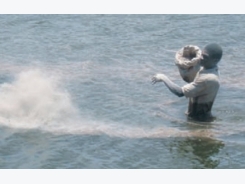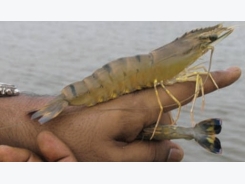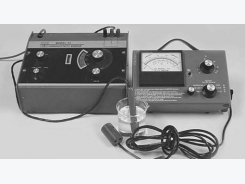Overview: Mechanical Pond Aeration

Productivity increases in aquaculture ponds in re-sponse to nutrient inputs of fertilizer and feed. These in-puts, however, increase the demand for oxygen by organ-isms, and low concentrations of dissolved oxygen can occur in pond water.
Experience and calculations suggest that production can be increased by about 400 kg for each horsepower of aeration applied.
Usually, low dissolved-oxygen concentrations occur during early morning hours, but also result from phyto-plankton dieoffs and cloudy weather. Most species of fish and shrimp are stressed by dissolved-oxygen concentra-tions below 3 or 4 mg/l. In ponds with consistently low con-centrations, culture organisms usually have diminished appetites, greater susceptibility to disease, and higher mortality. Feed-conversion efficiency and production ac-cordingly suffer.
Mechanical aeration is used widely in pond aquaculture to prevent low dissolved-oxygen concentrations, especial-ly at night; improve the efficiency of feed use; and increase production of the culture species.
Dissolved Oxygen
The capacity of water to dissolve oxygen depends upon atmospheric pressure, oxygen percentage in the air, water temperature, and salinity. Representative concen-trations of dissolved oxygen at saturation in waters of different salinities and temperatures are provided in Table 1.
The tabular values of dissolved oxygen are for water in contact with the atmosphere at 760 mm mercury, nor-mal barometric pressure at sea level. The saturation con-centration of dissolved oxygen (DO) for any other baro-metric pressure is estimated as follows:

Table 1. Solubility of dissolved oxygen (mg/l) in water at standard atmosphere pressure (760 mm Hg).
| Temperature (° C) | Salinity (ppt) | ||||
| 0 | 10 | 20 | 30 | 40 | |
| 10 | 11.28 | 10.58 | 9.93 | 9.32 | 8.75 |
| 15 | 10.07 | 9.47 | 8.91 | 8.38 | 7.88 |
| 20 | 9.08 | 8.56 | 8.06 | 7.60 | 7.17 |
| 25 | 8.24 | 7.79 | 7.36 | 6.95 | 6.56 |
| 30 | 7.54 | 7.14 | 6.75 | 6.39 | 6.05 |
| 35 | 6.93 | 6.58 | 6.24 | 5.91 | 5.61 |
Barometric pressure changes continuously, but these changes are minor. The main factor causing differences in barometric pressure is elevation. Barometric pressure declines with increasing elevation (Table 2).
Dissolved oxygen diffuses between air and water in response to oxygen pressure. The oxygen pressure is rough-ly 21% of barometric pressure because 20.95% of normal air is oxygen. The oxygen pressures in air and water are equal when water is saturated with dissolved oxygen.
During daytime, pond water often has a dissolved-oxy-gen concentration greater than saturation because of oxy-gen released by the photosynthesis of phytoplankton. In this situation, known as supersaturation, oxygen diffus-es from the water to the air because the pressure of oxy-gen in water is greater than in air.
At night, when photosynthesis stops, respiration con-tinues and dissolved-oxygen concentrations often fall below saturation. Nevertheless, the diffusion of oxygen into the water seldom is fast enough to prevent dissolved-oxygen concentrations from steadily declining in unaer-ated aquaculture ponds at night.
Mechanical Aerators
Mechanical aerators increase the rate at which oxy-gen from air enters water by providing a greater surface area between the air and water to facilitate diffusion. This can be achieved mechanically by two methods.
Water can be splashed into air to increase its surface area and accelerate the rate of diffusion. Alternatively, bubbles of air released into water create a large surface area between the bubbles and water through which oxy-gen from the bubbles enters the water. Both “splasher” and “bubbler” aerators can be effective.
It is important to note that aerators are most effective when dissolved-oxygen concentrations in water are very low, for the driving force causing oxygen to enter the water is the difference in pressure between the oxygen in the air and the oxygen in the water. Moreover, when water is supersaturated with dissolved oxygen, most aer-ators transfer oxygen from water to air as deoxygenators.
Table 2. Barometric pressure for different elevations.
| Elevation (m) | Barometric Pressure (mm Hg) | Elevation (m) | Barometric Pressure (mm Hg) |
| 0 | 760 | 1,250 | 657 |
| 250 | 738 | 1,500 | 638 |
| 500 | 717 | 1,750 | 620 |
| 750 | 696 | 2,000 | 602 |
| 1,000 | 676 | 2,250 | 585 |

Water Circulation
In addition to transferring oxygen to water, aerators circulate pond water. Water circulation is beneficial in moving oxygenated water away from aerators to prevent localized saturation and loss of oxygen-transfer efficien-cy. It prevents ponds from thermally stratifying. Aerator-induced water currents transport oxygen throughout the pond for use by the culture species.
Circulation creates ripples on the water surface that favor the outward diffusion of ammonia and other toxic gases. It also delivers water containing dissolved oxygen over pond bottoms to avoid localized pockets of anaero-bic sediment.
In intensive ponds, aeration is necessary during day-time to provide circulation even though little or no oxy-gen transfer results. However, the amount of aeration ap-plied usually should be reduced during daytime to mini-mize oxygen loss to the air and lessen energy costs. At night, aeration should be increased to prevent low dis-solved-oxygen concentrations.
Aerator Types
There are many kinds of mechanical aerators. The most common types of splasher aerators are paddle-wheel aerators and vertical turbine aerators. One type of bubbler aerator is the diffused-air aeration system, which releases bubbles of air near pond bottoms to rise through the water column. Another type is the propeller-aspira-tor-pump aerator, which releases tiny air bubbles into tur-bulent water created by a rapidly rotating impeller.
Aeration Efficiency
Mechanical aerators are subjected to oxygen-transfer tests, and manufacturers often report standard aeration efficiency (SAE) values for their aerators. SAE is the quan-tity of oxygen an aerator will transfer per horsepower in one hour. Typical SAE values for aerators used in aqua-culture range 1-2 kg oxygen/hp/hour.
SAE is measured for 20° C, 0 mg/l dissolved oxygen and clear tap water. During operation in a pond contain-ing 3-4 mg/l dissolved oxygen, the actual oxygen-transfer rate will be 40-50% of the SAE given by the manufacturer or vendor.
Aeration and Production
There have been few careful studies of the increase in fish and shrimp production that can be expected per horse-power of aeration. Nevertheless, experience and calcula-tions based on pond oxygen budgets suggest that produc-tion can be increased by about 400 kg for each horsepow-er of aeration applied.
For example, suppose 1,500 kg/ha can be produced without mechanical aeration. To increase production by 3,500 kg to 5,000 kg/ha, the minimum aeration require-ment is about 9 hp/ha (3,500 kg/ha 400 kg/hp), but to be safe, probably no less than 1.5 times the minimum, 14 hp/ha, should be used.
Aerator Positioning
Few studies have examined the best ways of position-ing aerators in ponds. Fish move to aerated zones, so po-sitioning is less important in fish ponds than shrimp ponds. In fact, in channel catfish farming, all aerators often are located in one end of the pond. This practice al-lows the use of a single electrical service panel and great-ly reduces the amount of electrical wire between the panel and aerators.
In shrimp ponds, the long-standing practice of posi-tioning aerators to create a circular movement of water is probably as good as any other alternative. To avoid ero-sion, aerators should not be mounted in water less than 0.75 m deep or near embankments. Water currents also should not impinge on embankments for the same rea-son. Moreover, water currents from one aerator should not collide with currents from another.
Safety Considerations
Aerators are dangerous pieces of equipment because they are electrically powered and operate in water. They also have rapidly rotating parts. Workers should be care-fully trained about aerator use and electrical safety to avoid accidents. No one should closely approach an oper-ating aerator by wading or in a small boat.
Related news
Tools

Phối trộn thức ăn chăn nuôi

Pha dung dịch thủy canh

Định mức cho tôm ăn

Phối trộn phân bón NPK

Xác định tỷ lệ tôm sống

Chuyển đổi đơn vị phân bón

Xác định công suất sục khí

Chuyển đổi đơn vị tôm

Tính diện tích nhà kính

Tính thể tích ao




 Mechanical Water Circulation Aids Pond Water Quality
Mechanical Water Circulation Aids Pond Water Quality  Specific Conductance – Alternative Salinity Measurement
Specific Conductance – Alternative Salinity Measurement